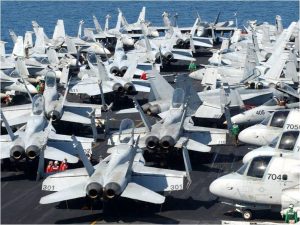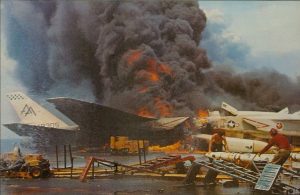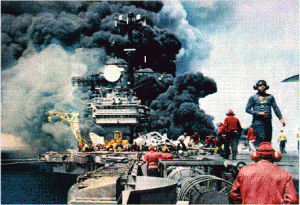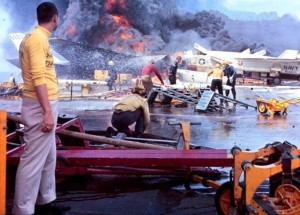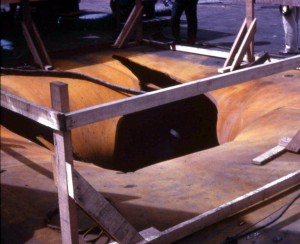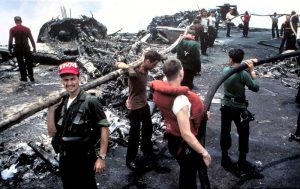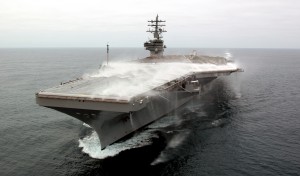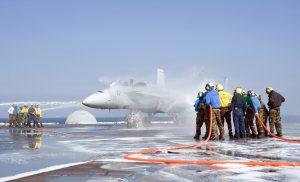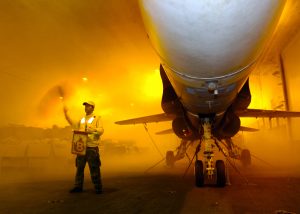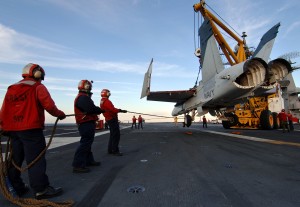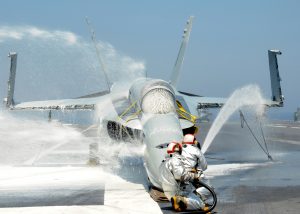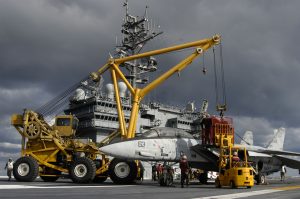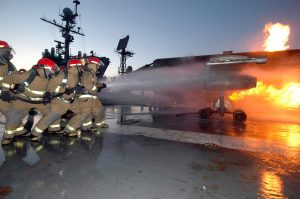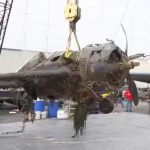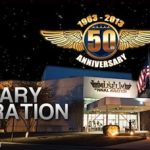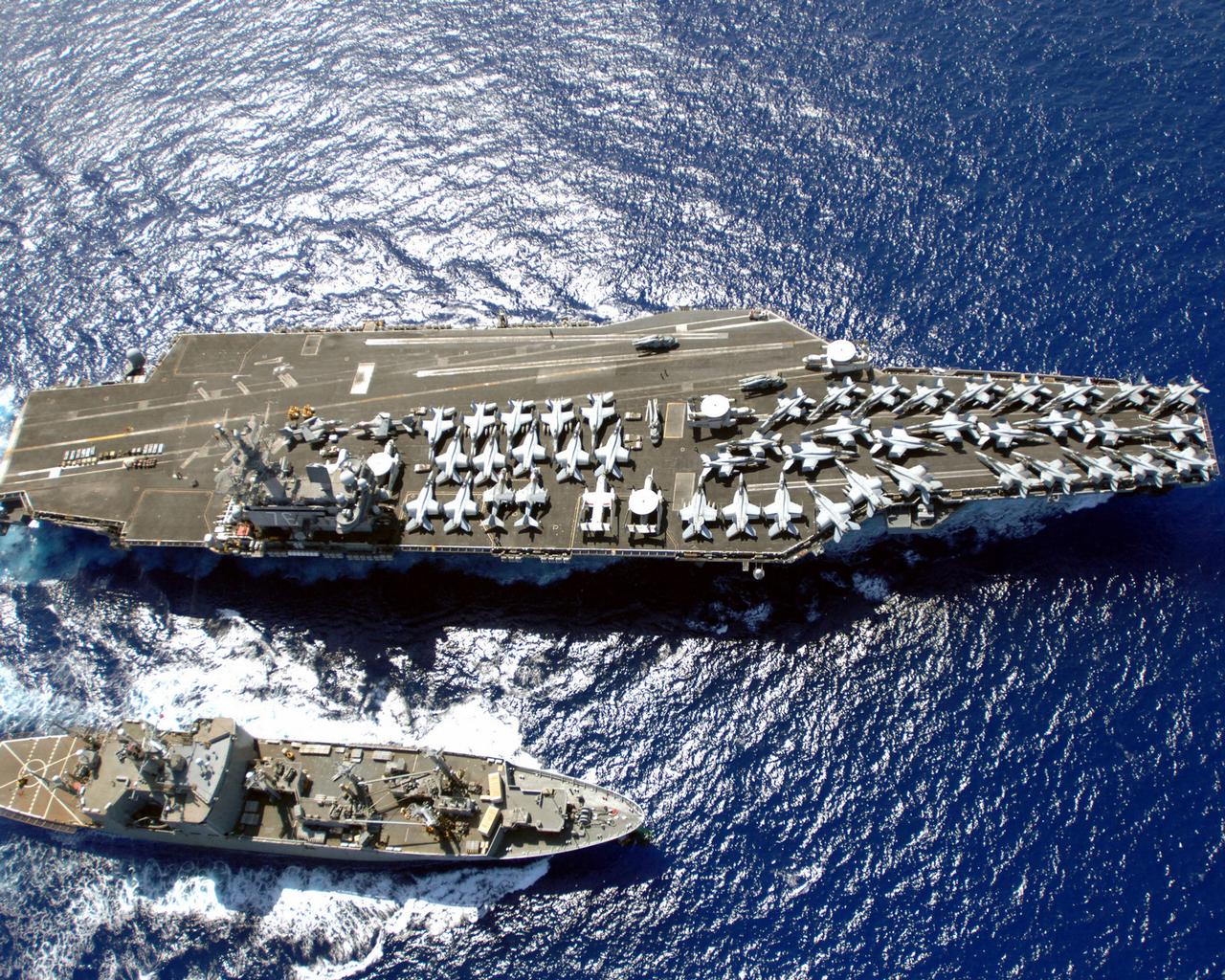
(Image Credit: US Navy)
The US Navy currently operates 10 Nimitz-class supercarriers, portable military airports which give the United States the ability to project power nearly anywhere on the globe. These are gargantuan ships, 1,100 feet long and weighing in at 114,000 tons (or 228 million pounds for those who enjoy really huge numbers). Large as they are, unlike land-based airbases, which have the luxury of mandating minimum separation distances between runways, taxiways and flight lines, and the ability to remotely locate fuel farms and ammunition depots, on an aircraft carrier those distances and safety margins are simply impossible to achieve.
(Image Credit: US Navy)
An aircraft carriers’ flight deck is a concentrated hazard zone, with lots of aircraft, both fixed-wing and helicopter, taking off, landing, moving about and being parked with only inches to spare. Aircraft are loaded with fuel and ordinance not to mention the hazards of support vehicles moving ordinance, fuel being pumped in and out of aircraft and flight crews scurrying about making the operations happen, all on a flight deck that is in constant motion, often on multiple axes. In this fast-paced environment with every danger in such close proximity to yet another danger, small accidents can quickly lead to full-scale disasters with tremendous losses to equipment and life. The carriers are also warships and as such, enemy attack is also a very real possibility that must be prepared for.
(Image Credit: US Navy)
The hazards of the environment were perfectly illustrated by the tragic USS Forrestal Fire of July 29, 1967. Stationed in the Gulf of Tonkin during the Vietnam War, the Forrestal
(CVA-59), was engaged in flight operations when, at around 10:50AM, a Mk-32 “Zuni” rocket mounted to a McDonnell Douglas F-4B Phantom II accidentally fired due to a stray electrical power surge caused by the switch from external to internal power. The rocket raced across the flight deck and struck an external fuel tank on a Douglas A-4E Skyhawk which was awaiting launch. While the Zuni’s warhead safety mechanism prevented it from detonating, the impact tore the tank off the wing and ignited the resulting spray of jet fuel. Within seconds, the other external fuel tanks on the Skyhawk overheated and ruptured, releasing more jet fuel to feed the flames, which began spreading along the flight deck. The impact of the Zuni had also dislodged two of the plane’s Korean War-era 1000-lb AN-M65 bombs, which fell to the deck and lay in the pool of burning fuel. Despite the heroic efforts of a Damage Control team to cool the bombs with a PKP fire extinguisher, one of the bombs detonated, just a minute and 36 seconds after the fire had begun.
(Image Credit : US Navy)
(Image Credit: US Navy)
The bomb detonation destroyed the previously-struck A4 as well as the Skyhawk that was adjacent to it, its pilot (Lieutenant Commander John McCain, by the way), having recognized the impending disaster at hand had scrambled out of his cockpit just moments earlier, and the bomb detonation ignited the fuel and ordnance of both Skyhawks, blowing a crater in the armored flight deck and peppering the deck and crew with bomb shrapnel and burning fuel. In the tightly packed formation on the deck, two more A-4s, both fully fueled and bomb-laden, began to burn, causing the fire to spread and more bombs to explode. Nine bomb explosions eventually occurred on the flight deck, eight caused by the AN-M56 Composition B bombs cooking off under the heat of the fuel fires and the ninth occurring as a sympathetic detonation between an AN-M65 and a newer 500 lb M117 H6 bomb that it was lying next to on the deck. The other H6-based bombs performed as designed and either burned out on the deck or were jettisoned, but did not detonate under the heat of the fires. The explosions, later estimated to up to 50% more powerful than a standard 1000 lb bomb due to the unintentionally-enhanced power of the past it’s expiration date Composition B contained in the old bombs, tore large holes in the armored flight deck, causing flaming jet fuel to drain into the interior of the ship, including living quarters located directly underneath the flight deck as well as the below-decks aircraft hangar.
(Image Credit: US Navy)
(Image Source: US Navy)
(Image Credit: US Navy)
(Image Credit: US Navy)
(CVN 75)
(Image Credit: US Navy)
Sailors and marines controlled the flight deck fires by 12:15PM, and continued to clear smoke and to cool the hot steel with sea water on the 02 and 03 levels. All fires were declared under control by 1:42PM, though the fire was not declared defeated until 4:00AM the next morning, due to additional flare-ups that continued to occur through the day and night following of the disaster.
The fire left 134 crewmen dead and 161 more injured. Many planes and armament were jettisoned to prevent them from catching fire or exploding and 21 additional aircraft also sustained enough damage from fire, explosions and the salt water used to fight the conflagration to be stricken from the navy’s inventory. Even today the navy commonly refers to the fire aboard the Forrestal, when teaching damage control and ammunition safety. All new navy recruits are required to view a training video produced from footage of the Forrestal’s fire and damage control efforts, that points out techniques both successful and unsuccessful. In the Forrestal fire on one side of the deck there were damage control teams spraying fire fighting foam on the deck to contain the flames, which was the correct procedure, while crewmen on the other side of the deck sprayed seawater which washed away the foam and worsened the situation by sending burning fuel through the holes blown through the flight deck and into the ship below. Due to the first bomb blast killing nearly all of the specially-trained firefighters on the ship, the remaining crew who had no formal firefighting training whatsoever, were forced to improvise, facing a situation they were ill prepared for.
In response to the tragedy on the Forrestal, a 20-zone flight deck “wash down” system was incorporated into all US carriers, which floods the flight deck with up to 27000 gallons per minute of fire suppressing foam or water depending on the situation faced and 22 dual-hose foam or seawater selectable firefighting stations placed around the deck. Heavy-duty armored forklifts for use in the emergency jettisoning of aircraft and heavy or damaged ordnance became required equipment for every carrier in the fleet, and mandatory fire-fighting training was given to all personnel regardless of their ultimate duties aboard ship. All carriers are also now equipped with a dedicated fire-fighting team and a vehicle called the A/S32P-25, more commonly referred to as a “P-25”, which is a scaled-down version of a fire tanker truck specifically designed for carrier duty and is always strategically-positioned to provide a rapid response in case of an accident or fire.
(Image Credit: US Navy)
(Image Credit: US Navy)
(Image Credit: US Navy)
Other lessons learned have resulted in near-constant training and drills to prepare for emergencies. Since active jets are precious assets, they use specially-prepared training airframes, like grounded F-18 Hornets whose flying days have ended. Stored in a corner on the hangar deck until called upon for training exercises, these former frontline fighters are often antiquated models of current equipment or planes that have been damaged beyond the point of repair. These days the trainers are usually represented by earlier models of the F-18 whose variant has been retired, but whether antiquated or damaged, these warbirds continue their service to the navy by serving as training aids for firefighting and crash retrieval and salvage operations, letting crews hone their skills using real world items, without risking damage to expensive operational flyers.
Other training is conducted with a simulated airplane, the Mobile Aircraft Firefighting Training Device or MAFTD in Navy parlance. The MAFTD uses propane gas to create several independently-controlled fires from various locations, permitting the simulation of the different types of fires that are possible on carrier-based aircraft.
It’s somewhat telling that while aircraft carriers continue to be one of the most dangerous places on earth and there are indeed accidents and fires that still occur, with the constant drilling and the application of lessons learned at great cost, there has never been an incident post-Forestal that has approached the level of damage or loss of life that occurred on that morning 46 years ago.
Trial by Fire: A Carrier Fights for Life a 1973 United States Navy Educational Documentary that contains extensive footage of the USS Forrestal fire and safety procedures that must be followed to prevent a repeat of the disaster:
http://www.youtube.com/watch?v=Bqz0cS_82vw








